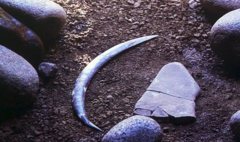Remarkably, an ancient boomerang found in Poland now reveals deeper insights into human innovation and hunting practices from 40,000 years ago.
Oldest Boomerang Unearthed in Poland: A Hunt Tool from 40,000 Years Ago

Oldest Boomerang Unearthed in Poland: A Hunt Tool from 40,000 Years Ago
Discoveries change perceptions of ancient human craftsmanship through a newly dated boomerang.
The world's oldest boomerang, discovered in a cave in Poland, has redefined our understanding of early human ingenuity with its new dating pushing its age back to an astonishing 40,000 years. Initially believed to be about 30,000 years old, new radiocarbon dating of accompanying animal and human bones has revealed that this remarkable tool, crafted from a mammoth's tusk, predates earlier estimations by a significant margin.
Found in Oblazowa Cave in southern Poland, the boomerang was skillfully shaped to ensure flight when thrown, although it lacked the ability to return to the thrower, indicating its likely use as a hunting implement. Its symmetrical design and polished surface suggest considerable craftsmanship, pointing to the cultural or ritualistic significance it may have held among its users. Dr. Sahra Talamo from the University of Bologna highlighted that this single artifact gives a "remarkable insight" into Homo sapiens' expertise in shaping functional objects for survival, dating back to around 42,000 years ago.
The boomerang measures about the size of a baseball bat, exhibiting wear patterns consistent with use by a right-handed individual. While boomerangs are often associated with Aboriginal cultures in Australia, evidence suggests that similar tools existed on various continents, although the oldest example from Australia dates back only to roughly 10,500 years ago.
Beyond Poland, other notable findings of ancient boomerangs include one made from wood that was discovered in Denmark, dating back 7,000 years, and another oak fragment from the Netherlands, approximately 2,000 years old, that maintains the characteristic return feature.
The research has been conducted by an international team of scientists from multiple countries and their findings have been published in the academic journal PLOS One, paving the way for further investigations into the sophisticated skills of our ancient ancestors.




















